 Research Article
Research Article
The Use of Mobile Apps for Health and Fashion Management in South Korea
Yoon Kyung Lee1 and Min Sun Lee2*
1College of Human Ecology, Seoul National University, South Korea
2Department of Fashion & Textiles, Sangmyung University, South Kore
Min Sun Lee, Dept. Fashion & Textiles Sangmyung University, Seoul, South Korea.
Received Date: August 28, 2019 Published Date: September 04, 2019
Abstract
The use of mobile apps for body and appearance management to promote health and well-being has grown rapidly in recent years. The objectives of this study are to define a relation between health care and appearance management and understand the objective of using mobile health apps and fashion styling apps for the design and development of new apps. This study was conducted on Koreans in their 20s and 30s, residing in Seoul and around, from April to June 2018. The data were analyzed using SPSS 25. A close affinity was discovered between the users of mobile apps for health and fashion styling. They used the apps for getting new information and checking their condition to plan future steps. It needs to move in a wormlike manner both health app and fashion styling apps for the efficiency revitalization of digitalization in well-being promotion.
Keywords: App; Well-being; Health care; Fashion styling
Abbreviations: App (Application)
Introduction
With the recent emphasis on balancing work and life, Warraval’s life, which stands for Work and Life Balance, has become a trend. This atmosphere shows that in modern times, people tired of materialism are taking health and happiness as their main values in life, paying attention to ways to improve their quality of life. Wellbeing in adults is a very complex and multidimensional element. Therefore, the improvement of quality in life is directly related to the improvement of satisfaction with life. For this reason, wellbeing starts from physical and psychological health and satisfaction with it.
McAuley et al. (2005) [1] suggest that physical activity is a pathway to improve self-esteem, which in turn leads to a successful and satisfying life and improves well-being. Physical activity and self-efficacy grow through a virtuous cycle of influence, which affects physical condition and physical esteem represented by the attractive body and physical strength. Thus, physical self-esteem affects overall self- esteem. Appearance management behavior through physical activity and fashion can be an effective alternative to well-being, improving overall self-esteem by increasing the satisfaction with not only physical condition and physical strength but also the attractiveness of the body [2-4].
In this trend, various digital media have recently provided ways to utilize and expand health and personal tastes. As a representative example, with the use of smartphones expanding to a nationwide level, there has been a growth of services provided in mobile applications or apps. According to a study by Stoyanov et al. [5], mobile apps have a social interest in health and well-being, and there are 440 million health-related apps worldwide, with a 5% annual growth rate. In addition, with the steady growth of the smartphone market, health information and various contents related to it play an effective role as a medium to check their health anytime and anywhere. In addition, various ways to make people look more attractive and beautiful, weight loss guides provided by fitness magazines, and how to build a healthy and beautiful body are constantly being developed as mobile apps [6
Fashion apps are no exception. The application of fashion apps has expanded into a full-fledged fashion styling function. Thus, fashion brands at home and abroad show fashion brand information through their apps; including the brand collections, catalogs and look books that change every season, and the types and quantities of fashion items that change in real time. This leads to fashion brand advertising and sales effects such as sales growth, brand awareness, and customer management. As mentioned above, this positive effect of fashion apps is expected. Existing studies of fashion apps have been mainly focused on classifying types according to the function of fashion apps. It is necessary for new research to define the elements of the fashion app to improve various services and the purpose of using the fashion app user rather than only classifying the types of apps by the functions.
In addition, it is meaningful to examine the correlation between fashion and health- which is more closely related to the body-together with the positive outlook for the digital fashion and healthcare industry. Therefore, in this study, we want to investigate the changes needed in fashion apps in order to activate the digital fashion industry and to expand the usefulness and utilization of the smart phone app that can be effectively accessed in terms of physical, health care and appearance management.
The objectives of this study are as follows:
1. First, to clarify the main purpose of using healthcare apps and fashion styling apps for young Koreans in their 20s and 30s.
2. Second, to identify the relationship between healthcare app and fashion styling app users.
3. Third, to provide the requirements for fashion app development in the future that can be effectively approached in relation to physical health care and appearance management through fashion.
Development and Status of Mobile App
App, in its dictionary form “application,” means “of a particular use.” The software term app echoes this, indicating a program that is designed for a particular use. The smartphone app is a mobile program capable of two- way communication, it is always portable and easy to update, so you can receive new information quickly and conveniently in real time [7]. Furthermore, according to the 2017 Korea Social Indicators released by the National Statistical Office, Korea’s smartphone subscription rate is 90.6%-the highest worldwide [8]. Along with the increase in the number of smartphone subscribers, the use of apps on smartphones is steadily increasing. Among them, the highest interest and utilization of smart phone users is in health-related apps. According to data released by market research firm Statista, the global digital health market is expected to reach $144 billion in 2018. The domestic digital healthcare market has also grown at an annual average of 12.5% from 3 trillion won in 2014 and is expected to grow to 14 trillion won by 2020. In particular, the mobile health sector recorded the highest growth rate among the average annual growth rate of the healthcare sector, with a growth rate of 41% [9]. Likewise, in the digital health field, the health app shows a high growth rate and a positive outlook for the future [10].
Regarding the use of such a health app, BinDhim, et al. [11] presented the efficiency of health management through the App. They explain that 93% of mobile health app users are more effective at losing weight than health care providers who use websites (55%) or pagers (53%). In addition, encouraging them to manage their own health through mobile apps can help reduce errors in following medical prescriptions. Therefore, the future development of the Health App should focus on a software solution that analyzes, processes and produces useful information by accumulating health information, collected either by the health device or through direct input by the user. Therefore, it is worth noting that the health app’s service consists of the core competency of the health care app to perform data, measurement, and analysis behavioral suggestion on the factors that may affect health in lifestyle behavior.
Healthcare App
In the case of the “S Health” App, the configuration allows users to check the recommended exercise amount according to a personal profile and select a goal suited to their preference. In addition, the S Health App provides tips for achieving the goal by recording activities such as diet, fitness, and exercise. In the main screen, you can check the exercise status and the recent health status according to the target. In addition to exercise activities, a variety of information such as nutritional balance scores can be recorded to set up a balanced lifestyle pattern [12]. LG Health also offers similar functions but is trying to differentiate itself with the “drinking water” function. In the case of “drinking water,” you set how much you want to drink per day in “Setting your daily health goal” and then set the interval to drink water in the “Notification” screen to induce health check. Google Health combines information from other apps such as OSWear OS by Google, Nike +, Runkeeper, Strava, MyFitnessPal, Lifesum, Basis, Sleep as Android, Withings, and Xiaomi Mi bands. It is supposed to be able to track. Google Health’s Google Fit is a kind of data central repository because it allows you to receive and share health information generated by various healthcare apps. You can send data generated by devices like Gear Fit and Nike Fuel band to Google Fit. The biggest difference from other health apps is that Google Fit makes use of integrated health data to its fullest and uses various fashion sports companies such as Nike and Adidas as partners.
As people’s desire to improve their health has increased with their growing interest in and expectation for quality of life, the App market has offered medical care, including exercise, diet control, chronic disease information and management, women’s health care, and personal health information management. It can be seen that various apps related to health and health are leading the digital market [13]. Providing user input and providing additional information through analysis of results. The data industry essentially determines the profitability of the entire industry because the amount and size of data determines the profitability of the entire industry [14]. As Nike and Adidas are already trying to make fashion a part of entertainment, the integration of health and fashion apps can be a very effective strategy, following this trend.
Fashion Styling App
Recently, as the interest in smartphones is increasing worldwide, including in Korea, fashion companies are participating in app development. With the expansion of digital fashion, the spread of fashion apps is preparing for the popularization of fashion beyond access to fashion information, sales, and fashion shows. This gives the public a chance to find their style more easily. Park, et al. [7] summarized the functions of the Fashion Styling App into seven functions. First, a basic information function that provides brand information and information such as price, size, color, etc. Second, quick communication with customers through Facebook and Twitter accounts. Third, coordinating with an avatar or taking a picture of yourself and then putting clothes on your picture to coordinate AR functions (Augmented Reality). Fourth, outdoor fashion, is a LBS function (Location Based Service) that provides a function to leave. Fifth, additional entertainment features including music listening, weather information, and diet programs. Sixth, mobile shopping functions. And finally, live streaming, which provides scarcity value by providing fashion show videos.
The various types of fashion apps include brand apps, fashion show apps, blog apps, community apps, magazine apps, shopping apps, and place management apps. According to the type of domestic fashion app, it can be represented as a style share, a codibook or a fitUin. Style Share provides a service that allows users to see the fashion content they consume in one place; it is not only for uploading photos of users but also for consulting with other users and providing services according to the way they share their styles (Figure 1).
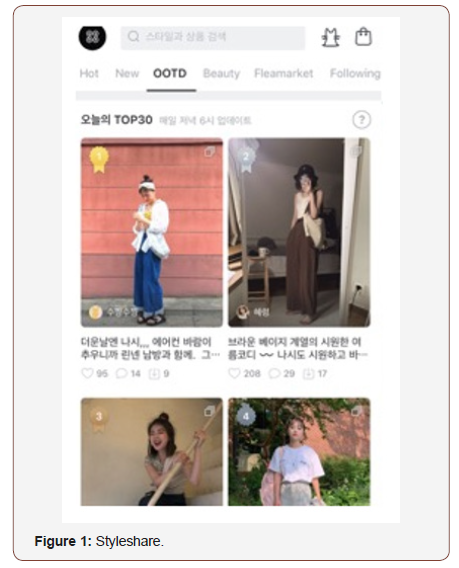
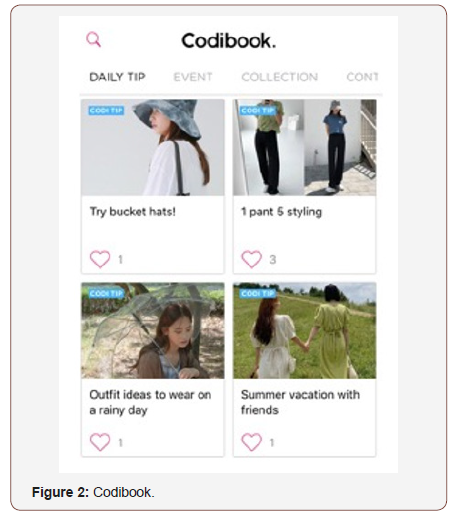
Interpark launched “fitUin” (unified as Picchuin) is a mobile fashion app that lets you virtually dress and style. Picchuin was also launched in March 2015 under the brand name “Magic Mirror” in China [17]. “Picchuin” is a new concept of fashion entertainment app where you can try and experience various fashion items. Unlike the unnatural fitting feeling of 3D virtual fitting system implemented through similar kinds of Apps, Picchuin provides a close fit [18]. App users can wear a variety of fashion products by taking pictures of themselves in addition to the male and female models provided by default. Users can save the completed photos to their tastes in to check their acquaintances. In addition, Picchuin is equipped with the ability to directly capture, capture and style magazines, online shopping malls, department store show windows and other clothing worn by others. As such, the current fashion app focuses on the use and sale of fashion information and items, rather than the service aspects associated with physical care or health care. Therefore, it is required to propose the use of healthier fashion by grasping the connection between the digital health industry and fashion in the recent atmosphere of healthy lifestyle trends.
Methods
In this study, we tried to investigate what kind of approach is needed in fashion apps to manage one’s body, health care and appearance, in the current atmosphere when the usefulness and utilization of mobile app is increasing. Therefore, this study is aimed at adult men and women in their 20s and 30s who have more interest and access to Apps in order to examine the use of health apps and fashion apps. There were 120 participants in this study— 26 males and 94 females—living in Seoul from April to June 2018. The average birth year of the participants in the study was 1994.34 (born 1980-1999).
The survey was conducted using an SNS survey. A five-point scale was used for the questionnaire about health care, appearance satisfaction, health and styling app usage status, and questions about the types of health and styling app were administered in a subjective manner. A majority of the total respondents surveyed said they had a positive perception of styling or body care behavior through fashion, excluding 1% (1) negative respondents. This study was conducted with 120 respondents who were positive for physical and appearance management. Most of the participants in this study (61.2%) perceived their body shape as average, 24% were dry, 4.1% were very thin, 14.9% were obese and 1.7% were very obese. The results of the final questionnaire were analyzed using SPSS 25.0.
Result and Discussion
Health care and appearance satisfaction
The purpose of this study was to examine the relationship between health and appearance satisfaction for participants in their 20s and 30s who are highly interested in fashion. The usage of these apps was as follows: not at all 21.7%, 1-2 hours: 45.8%, 2- 4 hours: 17.5%, 3-10 hours: 13.3%, and over 7 hours: 1.7%. The digital media used for healthcare were 10.5% using blogs related to health, 43.9% using videos related to health and exercise, and 5.3% using smart watches. Participants who consistently managed their bodies through weekly exercise showed high satisfaction with their appearance (p <.01, r = .268) (Table 1). They also found that the use of digital media on health was also high (p <.05, r = .192). Participants, especially in sports and fashion styling, showed a high appearance satisfaction level (p <.5), which allowed them to focus more on their interests, ‘health and body’ (Table 2). Participants who wanted to collect information were able to use digital media in health- related fields more easily, and they were acquiring information that could effectively improve their health in a more active way. In addition, the appearance management behavior through fashion improves the physical condition and physical fitness as well as the satisfaction of the attractive body to realize healthy well- being [19].
Table 1:Results of analysis the healthcare.

Table 2:Results of appearance satisfaction analysis.
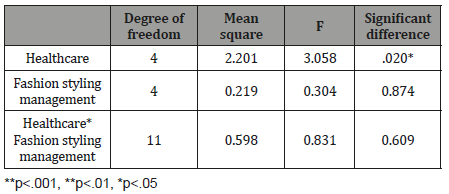
Using healthcare and fashion apps
Looking at the difference in the use of apps by age, there was a significant difference in the use of apps for participants in their 30s compared those in their 20s in health app use (p <.001, t = 2.371). This suggests that increasing interest in health as age increases may affect the use of the health app. In addition, those who use the health app showed more use of fashion-related digital media (p <.05, r = .235) and also a higher interest in fashion (p <.01, pearson = .241) (Table 3). Users of fashion styling apps also showed high use of health-related digital media, and those using the app usefully showed that the use of digital media was based on utilizing information according to their needs.
Table 3:Results of healthcare App user analysis.

In addition, in connection with the preliminary result that the greater the number of users interested in fashion, the higher the frequency of use of the health app, the participants who manage their fashion style and health using apps can use the same digital media. Showed a tendency to acquire. In particular, healthcare apps that allow individuals to keep and monitor their own health records through smartphones and wearable devices are integrated with apps that suggest styles according to the user’s health and physical conditions as well as fashion trends. If it works, it is more effective for users to use the app [20]. In addition, providing health content that reflects factors that can induce an early adopter’s interest based on an easy-to - use app system will help the spread of healthcare apps [13]. In this regard, the linkage between the fashion app and the health app, which has a large number of early adopters with high self-efficacy and individual innovation, will greatly contribute to the spread of the health app.
Using fashion styling app and healthcare
There was no significant difference between ages in the use of fashion styling apps, but the use of styling apps showed that the interest in fashion (p <.05) and appearance satisfaction (p <.05) were direct factors of using styling apps. >. Among the participants using healthcare apps, those who judge themselves as having a sense of fashion show high use of the fashion styling app. Thus, for those who manage their appearance through health and fashion rather than those who just manage health, the use of fashion -related styling apps are likely to be high (p <.05) (Table 4 & 5). These results suggest that it is possible to stimulate fashion curiosity in those who use the health app more than to appeal to those who are interested in fashion to the health app.
Table 4:Results of fashion styling App user analysis.
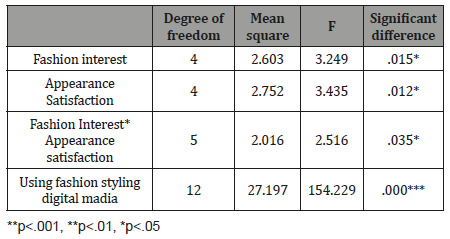
Table 5:Results of fashion styling App user analysis.
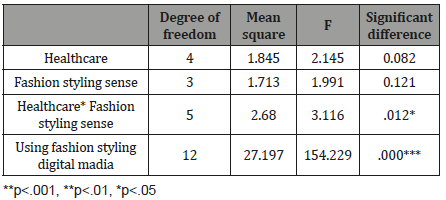
Conclusion
In modern society, as in Warraval, which means work-life balance, efforts to improve the quality of life and satisfaction by emphasizing health and happiness have become social trends. Reflecting this trend, smartphone-based apps provide services that can provide continuous interest and motivation by incorporating entertainment elements into health and physical care services by introducing two-way information communication through links with SNS services.
This study examined the characteristics of mobile apps, especially health apps and fashion apps, which are being used in the digital fashion industry. In order to connect the health app and the fashion app, we conducted a study to expand the usefulness and utilization of the mobile app for health and physical management and appearance management. First, look at the relationship between appearance management and appearance satisfaction through health care and fashion. Participants who consistently manage their bodies through weekly exercise are more satisfied with their appearance and have more information about their health and body. We were collecting information that could be managed more intensively. These people tended to make more active use of digital media in health-related fields, and they were acquiring information that could effectively improve their health in a more proactive way. In addition, those who performed appearance management behavior through physical activity and fashion were approaching healthier wellbeing by improving their physical condition and physical strength as well as their satisfaction with the appearance of their bodies.
Among young people in Korea in their 20s and 30s, health apps were being used for the purpose of planning for their own health. They also recognized that health apps are generally useful in managing their health. As fashion styling digital media, apps were being used for the purpose of acquiring the latest information quickly and effectively. Fashion styling app users (54.4%) recognized that the app is useful for fashion styling. In addition, users who were satisfied with their appearances recognized that styling apps were very useful.
The results revealed that among the users of the health app and the styling app, those with a greater interest in managing their physical appearance showed higher use of both apps. This expected effect could be used in the future. In addition, the more users are interested in fashion, the higher the frequency of use of the health app. In particular, participants who manage their appearance through fashion and health tend to acquire information by using the same medium, so the integrated app linkage between health and fashion will be effective. Accordingly, if the fashion styling app is integrated with user-centered and participating healthcare trends that allow individuals to keep and monitor their own health records through smartphones and wearable devices, more effective functions can be provided to users.
In addition, the link between fashion apps and health apps, which have a large number of early adopters with high self -efficacy and individual innovation, will greatly contribute to the spread of health apps. In addition, the fashion app will then serve as a path to healthy fashion by playing a leading role in making the whole body healthy and beautiful without stopping at merely external appearance by linking fashion and health by fusion and density. It is hoped that the application of this fashion app will lead to well- being by improving overall self-esteem that increases not only physical condition and fitness but also physical appearance satisfaction through exercise and fashion.
Acknowledgement
None.
Conflict of Interest
Authors declare no conflict of interest.
References
- McAuley E, Elavsky S, Motl RW, Konopack JF, Hu L, et al. (2005) Physical activity, self-efficacy, and self-esteem: Longitudinal relationships in older adults. The Journals of Gerontology Series B: Psychological Sciences and Social Sciences 60(5): 268–275.
- Bergman MM, Scott J (2001) Young adolescents’ wellbeing and healthrisk behaviors: Gender and socio-economic differences. Journal of adolescence 24(2): 183-197.
- McAuley E, Rudolph D (1995) Physical activity, aging, and psychological well-being. Journal of Aging and Physical Activity 3(1): 67-96.
- Rosenberg M (1965) Society and the adolescent self-image. Princeton, NJ: Princeton University Press, USA.
- Stoyanov SR, Hides L, Kavanagh DJ, Zelenko O, Tjondronegoro D, et al. (2015) Mobile app rating scale: a new tool for assessing the quality of health mobile apps. JMIR mHealth and uHealth 3(1): e27.
- Conlin L, Bissell K (2014) Beauty Ideals in the Checkout Aisle: Health- Related Messages in Women’s Fashion and Fitness Magazines. Journal of Magazine & New Media Research 15(2): 1-19.
- Park MA, Ko HJ (2014) The Analysis of the Characteristic Types of Fashion Brand Application -Concentrating on Korean Application cases. Journal of the Korean Society of Costume 64(1): 136-151.
- Yoo SI (2017) 90.6 out of 100 people are smart phone users. Electronic Journal.
- Berger
- Bae Y (2018) checking health with mobile.
- BinDhim NF, Trevena L (2015) There’s an app for that: a guide for healthcare practitioners and researchers on smart phone technology. Online J Public Health Inform 7(2): e218.
- Chae SO (2016) Smart healthcare App, the most popular is ‘S health.
- Wang BR, Park JY, Choi IY (2011) Influencing factors for thread option of smart phone healthcare application. The Journal of the Korea Contents Association 11(10): 396-404.
- Sme (2017) Technology Road map for SME.
- Joo SH (2018) STYLE SHARE “The secret to the growth of the No. 1 1020 generation.
- Ahn KE (2014) Custom Fashion Commerce, ‘CODIBOOK’.
- Sim SH (2015) Kelly’s optimistic return to North Korea’s six-party talks.
- Song HY (2015) Fashion styling app Picchuin, a blast from abroad… Cumulative 500,000 cases exceeded.
- Fox KR (1999) The influence of physical activity on mental well-being. Public Health Nutrition 2(3A): 411-418.
- IRS Global (2018) The global digital health Market in the period 2015– 2018, by major segment.
-
Min Sun Lee, Yoon Kyung Lee. The Use of Mobile Apps for Health and Fashion Management in South Korea. J Textile Sci & Fashion Tech. 3(5): 2019. JTSFT.MS.ID.000571.
-
App, Well-being, Health care, Fashion styling, Materialism
-

This work is licensed under a Creative Commons Attribution-NonCommercial 4.0 International License.






